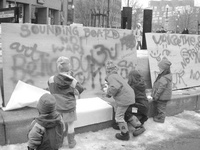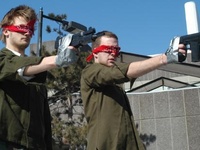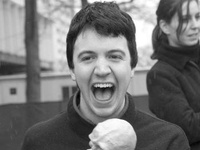Nearby, another group of students stages what appears to be a pro-war rally, though their mock chants are dubious to the careful listener.
With this powerful trio of vignettes, Performance Artists for Responsible Thought (PART) made their very public debut at Harvard last month. Formed in response to the then-impending war, PART aims to “use the impact of art and performance to bring information about social and political issues to a potentially wider audience than is afforded by traditional forms,” according to founder Susan E. McGregor ’04.
While the group—which has thus far staged three performances, or “actions”—is decidedly anti-war, organizers say the main goal of the demonstrations is to disseminate information and give voice to opinions that might otherwise not be widely publicized.
“Usually, the information we bring forward reflect issues that we feel are underrepresented in more traditional media, such as the majority of newspapers or television,” McGregor writes in an e-mail.
That information has included everything from announcements of rallies on other campuses to the contents of the Patriot Act.
Former Harvard-Radcliffe Dramatic Club (HRDC) President Daniel A. Cozzens ’03, who participated in PART, says he hopes the actions will not only pique people’s interest in the issues surrounding the war, but that observers will be inspired to take action themselves—on either side of the debate.
PART was inspired when McGregor attended a HIPJ meeting where students discussed a recent publicity stunt which involved two HRDC actors, bubble wrap and a joust.
“It occurred to me that staging theater compositions would be a more effective way of getting people to pay attention to certain issues than handing out leaflets, or even protesting,” McGregor says.
A few e-mails later she formed PART with some actor friends.
From Actor to Action
Before they perform, the group works collectively to create their four to seven minute compositions. Starting with a topic that they want to present, the group brainstorms ways to stage it. Compositions are based on gestures or motions that can be repeated and varied. After improvising with these gestures and topics, the group pieces together their performance.
The only requirement of each composition is that information and facts be incorporated in the piece, according to McGregor.
“I also make sure to cite the source of all information, so viewers can verify it or find out more for themselves,” McGregor says.
Letting the audience decide for itself is a major theme in PART’s stated mission—and McGregor and Cozzens both cite it as a reason why artistic protest can be more powerful than rallies. While protests can easily be ignored, they say, street theater impacts people differently. Not only do the actors provide entertainment, but, McGregor says, “they are informative but not necessarily obvious.”
“We are able to engage people because it takes some effort for them to figure out what’s going on, and we’re obvious enough that they’ll want to,” she says.
Read more in Arts
Season Opens with World Premiere















